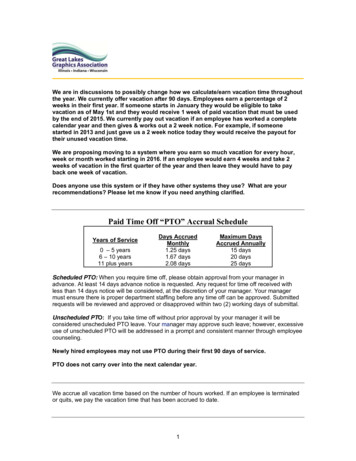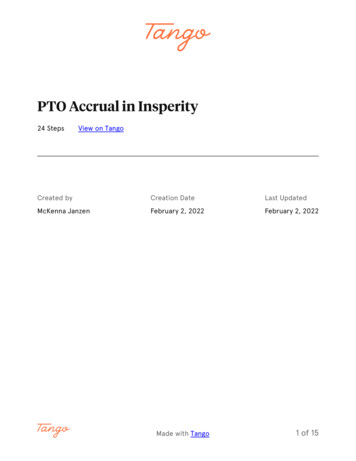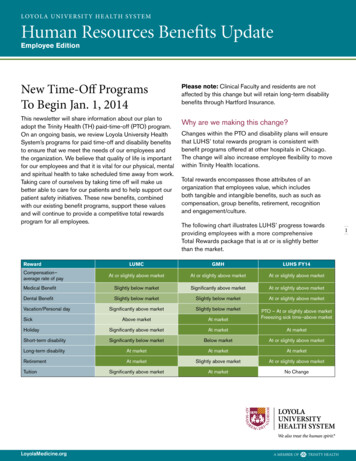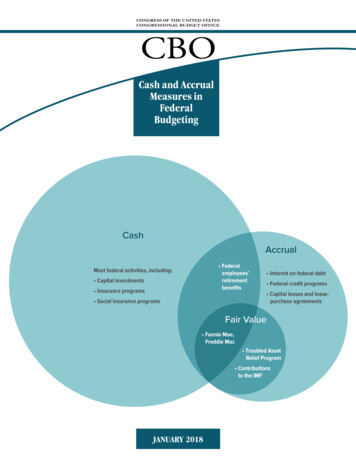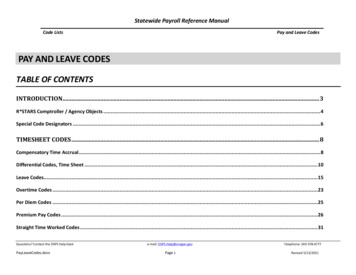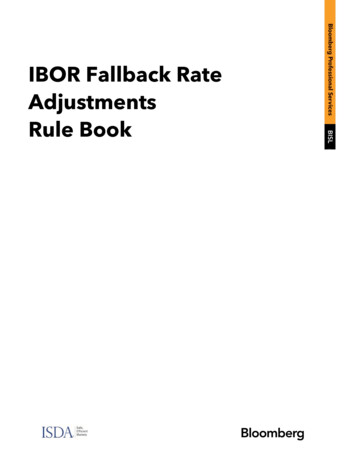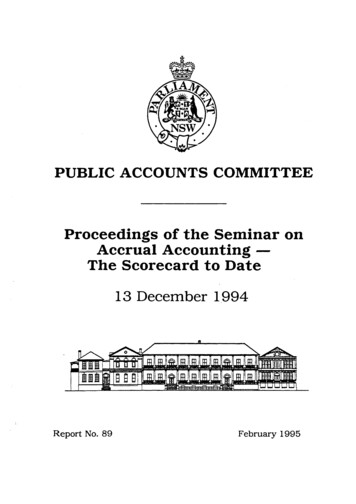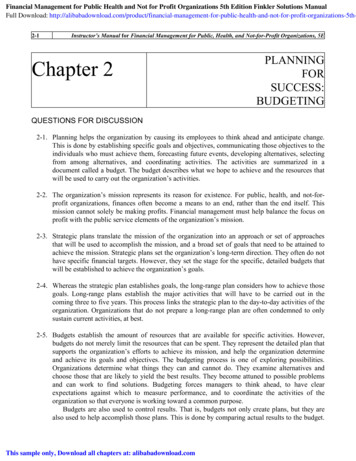
Transcription
PTO ACCRUALPOLICY TEMPLATE
IntroductionThe benefits you offer your employees can help attract great candidates, keep youremployees engaged, and reduce turnover. One of the most valued benefit offeringsis paying for time off. Employees need and want time away from the office toattend to personal and family matters as well as opportunities to recharge theirbatteries.Although you are not required by law to give compensation to employees whenthey are not at work (except sick leave—required in some states), if you decide tooffer this benefit, you should be prepared to do so in a fair and consistent mannerand you should document your policy in writing. In this template, we’ll helpyou determine which types of paid time off (PTO) you should offer and giveyou a template you can use to create consistent PTO policies across yourorganization.1
Part 1: Things to ConsiderWhen Crafting Your PolicyIn our decades of experience, we have seen PTO policies in all shapes and sizes. Ifyou are just beginning to draft a policy, or if you are in need of a policy reset, take alook at these tips.You can offer different “buckets” of time off, or youcan combine them all into one.By “buckets” we mean you can create separate policies for sick, personal, andvacation time by outlining distinguishing criteria for each. You can also combinethese policies into a single policy referred to as Paid Time Off (PTO) or EarnedTime Off (ETO).What are the advantages of each? Separate policies allow you to define specific criteria for each. (How muchtime is allowed? When do you earn the time? When must you use the time?Can it roll over?) Having separate policies also allows you to limit what getspaid out upon termination of employment. In Massachusetts, vacation time isconsidered “wages” and therefore any accrued, unused vacation time must bepaid out upon termination of employment, whereas sick and personal time arenot subject to this requirement.2
One combined PTO policy can be a lot easier to manage—there’s no need fortracking multiple categories of time off. Employees like the flexibility it offers(they don’t need to fake being sick because they can use this time off for anyreason). Keep in mind, though, that accrued, unused time would be viewed as“wages” in Massachusetts and would be subject to payout upon termination.Determine how you want the employees to earn thetime off—all at once or accrued in increments over aperiod of time.If you allow employees to receive the entire amount all at once, this is anallotment. If you want your employees to earn bits of time each pay period, thisis referred to as an accrual. You can also set the accrual amount to calculate pereach hour worked.For example, your policy can “accrue 40 hours per year” or you can be “allotted40 hours per year” and these mean very different things. If I accrue 40 hours per year, I accrue .7692 hours per week (which I may use as Iaccrue) and after I have worked 52 weeks (1 year), I will have accrued 40 hours. If I accrue 40 hours per year, I accrue .01923 for each hour worked (which I mayuse as I accrue) and after I have worked 2080 hours (1 year), I will have accrued40 hours. If I am allotted 40 hours per year, I receive 40 hours at the beginning of thatyear to use immediately and I won’t receive any additional time until thebeginning of the next year.3
You will also want to decide if employees should wait before they accrue or receivethese benefits. Companies with a high rate of turnover may want employees to beemployed for a period of time (typically 30, 60, or 90 days) before they have accessto paid time benefits. You may choose to require a wait before accruing or beforebeing allowed to use any time available. Keep in mind, though, that if an employeehas accrued the time and leaves before using it, you may be required by state law topay out any accrued, unused time.Your policy should define what you mean by “per year.”There are three ways to define year as it relates to HR policy: anniversary, calendar,and fiscal. Be specific in your policy language so that employees understand whentheir time off will be available to them and when it will renew or expire. Anniversary-year policies start on the date of an employee’s hire and reneweach year on the anniversary date. These policies tend to be easy for employeesto understand but can be hard for employers to keep track of, since anniversarydates will be different for all employees. Calendar-year policies run from January 1 to December 31 each year. These arefairly easy to administer as every employee has the same “year.” There are twopotential challenges that these policies face: Prorating in the first year can be confusing to employees—for example,understanding that they get 40 hours per year, but if they start in July,they will only have 20 hours available in the first year. For calendar year policies, you could be faced with everyone askingfor the last week of the year off work unless you allow employees torollover unlimited amounts of time.4
Fiscal year policies run on a calendar year defined by your company. Theconsiderations are the same as with calendar year policies.Decide if you want to increase the accrual or allotmentamount based on length of service.Milestones can be used as a way to reward longevity. Some companies will offerincreased amounts of PTO to individuals after they achieve a certain length oftenure. Depending on your starting accrual amount, milestones can offer a niceincentive for your employees to stay long term. An example of this is a companythat offers two weeks vacation for the first two years, and three weeks vacationafter that.Be clear about what happens to any time left at the endof the year.Since time-off policies are a liability on your books (your way of ensuring you meetyour obligation to pay), you will likely want to limit how much time employeescan carry forward (aka “rollover”) from year to year. Employers typically want andexpect their employees to use their time off each year and the way to ensure that isto limit the amount of time that an employee can carry from one year to the next. Policies that don’t allow any rollover are essentially “use it or lose it” policies.While this achieves the goal of making sure employees use their time, it mayencourage them to take unplanned time off to prevent losing time they feel“entitled to.” It may also create resentment if an employee loses time at the endof the year because work was too busy to allow for the time off. These policiesneed to be monitored closely to avoid those pitfalls.5
Allowing a rollover of any amount typically reduces the unplanned time offissue as well as the resentment. You now have a company liability to paythis time as well as any additional accrued/allotted time in this next year—something you should be comfortable with before enacting a policy allowingtime to rollover into the next year. Watch for state laws here as well. Although you are not required by any stateto offer vacation or personal time (some states do require sick time), if you dooffer these time-off policies, you might have an obligation in some states toallow time to rollover from year to year.6
Part Two: Create Your PolicyDefinitionsTo get started documenting your policies, answer the questions in this section.They will help you define eligibility criteria as well as set boundaries for using timeoff. This exercise needs to be completed only once to set definitions for all paidtime offerings.1. Define full time (FT) and part time (PT). Full-time employees need to work a minimum of hours per week. Part-time employees need to work a minimum of hours per week and amaximum of hours per week.2. Define rehiring practices.If an employee leaves your company and then comes back, do they earn PTOstarting from the beginning (as if they were a new employee) or from where theyleft off? A rehire threshold can help you gauge this: If you come back within threemonths, for example, you get to stay “where you were” before you left. Does the accrual restart from year one?Yes If no, is there a rehire threshold?No No3 Months6 Months12 MonthsOtherIf there is a waiting period, does the rehire go through the waiting period again?YesNo7
3. Define absences for exempt & non-exempt employees.This section helps you define the amount of time employees are required to takeoff depending on if they are classified as exempt or non-exempt. Increments oftime are allowed. Genesis recommends half-day or full-day increments for exemptemployees and one-hour increments for non-exempt employees.ExemptNon-Exempt4. Approval processDo employees need written notice of approval to take time off? If so, how muchadvance notice is required?Yes, require written noticeIf yes, what amount of time is required?No8
Part 3: Determine Your PolicySpecifics With PTO AccrualPolicy TemplatesYou can print out and use as many of these templates as necessary to create one foreach type of accrual policy your company has.Printable Policy Template Starts on Next Page9
PTO Accrual Policy TemplateName Of This Accrual Policy (i.e., Vacation Full Time):Does this policy apply to all groups of employees? Specify who this policy applies to.YesNoIf no, list exclusions (Class or group, i.e., part-time or executives)1. Time Off Accrual Defined (Check One)Select the type of accrual you want to use for this template.VacationSickPersonalPTOOther (sabbatical, community service, floater, etc.)2. Accrual Year Cap Defined (Check One)Does this policy cap hours at the end of the calendar year, fiscal year, or theemployee’s hiring anniversary?Calendar YearAnniversary YearFiscal YearDefine Fiscal Year
3. Accrual Year Milestone Defined (Check One)This is when an employee accrual may change. When do you want to look at thesemilestones? Genesis recommendation: Reviewing by calendar year works better withallotments than accruals.Calendar YearAnniversary Year3a. Do you want to define milestones based on months or years?MonthYear4. Accrual Basis Defined (Check One)How do employees accrue time? (i.e., earning fraction of time per hour worked, etc.)Genesis recommendation: An accrual based on hours worked is better suited for part-timeemployees, as it self-prorates.Per Pay PeriodWill this accrual continue while an employee is on leave?YesNoAllotmentHours WorkedIf Hours Worked, select the following earnings codes (check all that apply):RegularOvertimeFloater PersonelHolidayJury DutyOtherPTOBereavementVacationSick
5. Accrual Rate/Milestone Periods DefinedDefine milestones and what you earn.Example 1: Accrual - Pay Period Accrual For Vacation TimeMilestone #BeginningFromMonthPay PeriodAccrualAmountMax 1361621206.1516017616Example 2: Accrual - Hours Worked (By Months) For Vacation TimeMilestone 240Example 3: Flat Amount For Vacation TimeMilestone #Beginning FromMonthAllotmentAmountAccrual StopBalanceMaximumCarryover1012013616212016017616
6. Waiting Period/Probationary Period DefinedDo employees go through a waiting period before accruing PTO? Do you wantthem to not accrue until a certain time has passed?YesIf yes, how long?1 month60 days90 daysNo6b. Is there a waiting period before employees are eligible to take accrued time?Genesis recommendation: Employees can accrue right away, but they must wait acertain period to take the time.YesIf yes, how long?No7. Is borrowing time allowed?If you allow borrowing, be consistent. Make sure your handbook contains languageclearly stating the employer takes back any unaccrued balances upon termination.Genesis recommends allowing borrowing up to a certain amount. Try to keep theborrowed time limited to the amount an employee could pay back in a pay period iftheir employment was terminated (i.e., weekly payroll 40 hours; biweekly 80 hours).YesIf yes, up to how much time?No
8. Can employees carry forward balances into next plan year?At the end of a defined year, whether it’s a calendar year, fiscal year, or hiringanniversary, do employees get to carry any amount of time over? If so, how much?Genesis recommendation: Calendar anniversaries can be more difficult because ifeveryone carries over at the same time, employees may all request the same time off.YesIf yes, how many hours is the limit?If yes AND no limit, what is the cap on the accrual (number of hours)?No9. Are there any differences in accrual between part time and full time?Genesis recommendation: Most clients want to have smaller accrual rates foremployees who work less than 40 hours. An hours-worked accrual basis takes care ofthis situation; if you don’t use hours worked, you should differentiate.YesIf yes, define part-time accrual:No10. Is cashing out vacation time for money allowed?Genesis recommendation: Don’t allow cash out (giving money in lieu of taking time).The goal of vacation is to have employees return to work refreshed from their timeaway.Yes
If yes, is there a limit to how many hours?If yes, when does cash out occur?NoNotes:Remember ThisAny benefit you give should be given consistently and be clearly stated in yourcompany’s handbook. If you’re consistent in how you provide the benefit, you candefend it and it will be understood among your employees.Have a question about paid time off or benefits we didn’t answer? We’re here tohelp. To learn more about best practices for paid time off and building successfulbenefit strategies, give us a call or contact us.
PTO Accrual Policy Template Name Of This Accrual Policy (i.e., Vacation Full Time): _ Does this policy apply to all groups of employees? Specify who this policy applies to. 1. Time Off Accrual Defined (Check One) 2. Accrual Year Cap Defined (Check One) Yes Vacation Calendar Year Personal No Sick Anniversary Year Fiscal Year PTO

